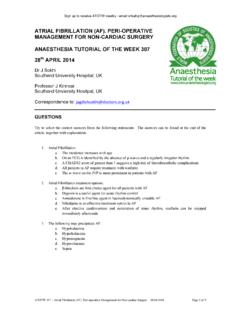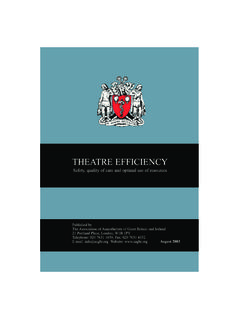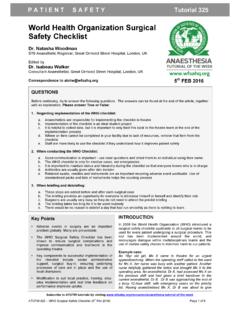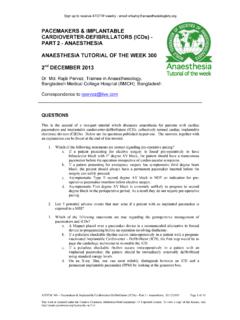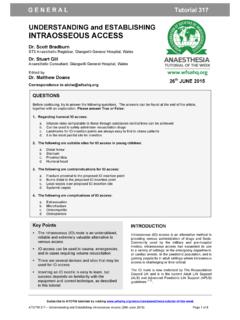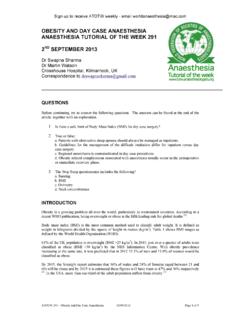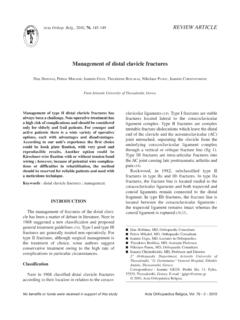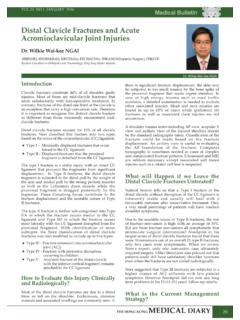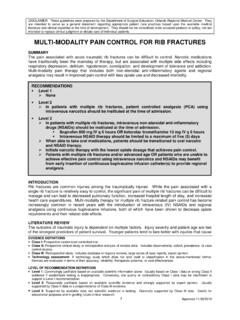Transcription of Management of Proximal Femoral Fractures - AAGBI
1 0 Management of Proximal Femoral Fractures 2011 1 Membership of the working party (details correct at the start of the working party process) Dr Jonathan Alper SAS Representative Dr Alex Beckingsale GAT Representative Dr David Goldhill Anaesthesia Editor Dr Richard Griffiths Chair, AAGBI Council Member Dr Gary Heyburn British Geriatric Society Representative Dr John Holloway Age Anaesthesia Association Representative Ms Elizabeth Leaper Trauma Theatre Co-ordinator, Poole Hospital NHS Trust Dr Martyn Parker British Orthopaedic Association Representative Dr Steve Ridgway Hip fracture Perioperative Network Representative Dr Stuart White Hip fracture Perioperative Network Research Lead Dr Martin Wiese College of Emergency Medicine Representative Dr Iain Wilson AAGBI Council Member The working party acknowledges the assistance of Prof Opinder Sahota and Dr Ian Moppett, Queens Medical Centre, Nottingham.
2 2 Contents 1. Introduction 3 2. Facilities and services required 4 3. Pre-operative Management 7 4. Ethical considerations 14 5. Intra-operative Management 15 6. Post-operative Management 22 7. Audit and research 24 8. Patient information 25 9. Training 26 10. Ten maxims of hip fracture care 27 11.
3 References 28 Appendix 1 31 Appendix 2 32 Appendix 3 33 3 1. Introduction Proximal Femoral Fractures present unique challenges for anaesthetic departments throughout Great Britain and Ireland, involving the perioperative care of large numbers of older patients with significant co-morbidities. Despite guidance since the early 1990s concerning best practice Management for these vulnerable patients [1-6], there remains considerable variation in models of perioperative care, rehabilitation and orthogeriatric input.
4 Approximately 77,000 hip Fractures occur in the United Kingdom annually, accounting for bed days, at an inpatient cost of Approximately 65,000 of these occur in England, with a median post-operative length of stay of 23 days and a thirty day mortality that has remained consistently around 8-10% for the last two decades although, again, there is considerable hospital variation in these figures [6, 7]. The majority (95%) of hip Fractures occur in patients over the age of 60, 75% occurring in females. More than 98% of Fractures are repaired surgically, for the purposes of analgesia and early rehabilitation. Approximately 25% of patients with hip Fractures have at least moderate cognitive impairment (abbreviated mental test score less than seven), 20% are institutionalised, and 50% require walking aids or are immobile.
5 As a result of the inadequacies of the evidence base on which most guidance is founded, there is limited consensus on best practice anaesthetic Management for hip fracture patients, which this document hopes to redress. These guidelines will mainly focus on the acute hospital episode, particularly the pre-operative period, intra-operative Management and immediate post-operative phase. Where evidence is limited, issues controversial or guidelines uninformative, the working party has provided pragmatic consensus opinions. In addition, these guidelines will describe the logistics of providing a high quality service for these patients, together with the important relationships that must be developed between departments to ensure quality care. This has been a multi-disciplinary collaboration, which has resulted in advice for anaesthetists, and other health care professionals on how to create, develop and manage a service for Proximal Femoral fracture .
6 4 2. Facilities and services required Older patients with hip fracture are at risk of significant morbidity and mortality, both of which can be reduced by prompt surgical fixation of the fracture and early, effective rehabilitation. This section outlines the structures and processes required to expedite early surgery and achieve high quality rehabilitation. The Department of Health has suggested the following targets for patients with hip fracture [8]: All patients to be admitted within 4 hours of arrival in the emergency department. Patients should be operated on by an experienced clinical team within 24 hours of a decision that the patient is fit for surgery. In addition, the British Orthopaedic Association Standards for Trauma (BOAST) guidelines stipulate that [9]: Hip fracture patients should be admitted within 4 hours to an appropriate clinical ward area with nursing, orthogeriatric medicine and surgical expertise appropriate for this often frail patient group.
7 Surgical fixation should not be delayed more than 48 hours from admission unless there are clear reversible medical conditions. For many hospitals, achievement of these standards may require service re-organisation, incorporating the following: Multidisciplinary hip fracture Management group This involves a broad collective of stakeholder personnel who meet regularly in order to discuss and improve the quality and efficiency of hip fracture care appropriate to a particular trust. The group may include trauma co-ordinators, general practitioners, community/falls assessment nurses, emergency medicine staff, bed managers, orthopaedic nursing staff, orthopaedic surgeons, anaesthetists, orthogeriatricians, physiotherapists and occupational therapists, social workers and rehabilitation services.
8 Trauma co-ordinators have a pivotal role, in reducing pre-operative delays, facilitating interdisciplinary communication, and instituting early discharge planning. Communication between the hip group and hospital theatre Management group improves integration of system changes into general theatre service provision. The fast-track admission pathway Most patients with hip fracture are admitted via an emergency department, where a planned care package should be initiated promptly. The use of a care pathway pro forma focuses patient care and ensures basic quality standards are met; a number of these exist, which can be tailored to individual hospitals. Continuous tracking/live data systems, which regularly update patient and logistical data, may improve patient Management by identifying patient location, delays in treatment and relevant clinical information, and may be used to facilitate clinical audit and business planning.
9 5 Trauma lists Specific trauma lists, separate from general emergency operating lists, improve the efficiency of trauma service provision. These should be provided daily, including weekends and bank holidays, and be staffed by appropriately experienced senior medical and theatre staff. Extra sessions should be made available flexibly in the evenings, when patient numbers exceed available operating space. Unless life or limb-threatening trauma intervenes, the working party suggests that hip fracture surgery is prioritised within operating lists, overriding the particular subspecialist interest of the surgeon assigned to the list. Multidisciplinary trauma meetings Daily multidisciplinary trauma meetings, prior to commencement of operating lists, offer excellent opportunities to communicate issues relating to recent admissions, to plan operative lists and equipment required for the day/next day, as well as providing regular teaching and feedback.
10 Trauma meetings with the surgical staff may include involvement of surgeons and their junior trainees, theatre staff, anaesthetics, orthogeriatric medicine, orthopaedic nursing staff and physiotherapy. Members of the trauma team may change on a daily basis, so handover of information is a key element. Communication of clinical information should always involve accurate documentation in patients notes in addition to verbal handover. A consultant-delivered service Older patients with hip fracture experience some of the worst clinical outcomes among the hospital population. It is not acceptable for these patients to be anaesthetised solely by inappropriately experienced anaesthetists. Ideally, a consultant anaesthetist or SAS should anaesthetise hip fracture patients with similar clinical experience; furthermore, randomly allocated consultants should not anaesthetise such patients.
